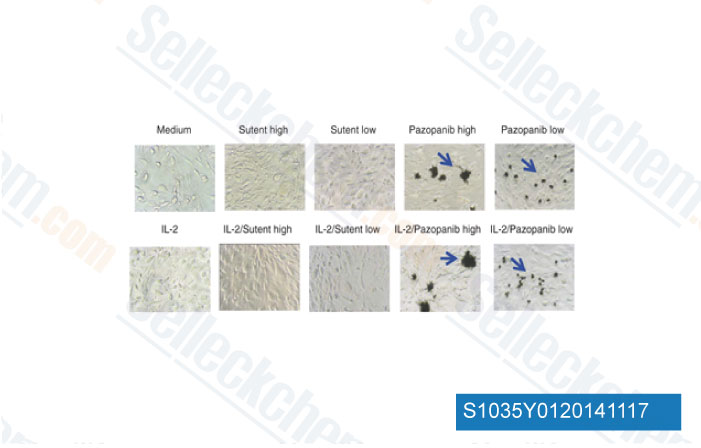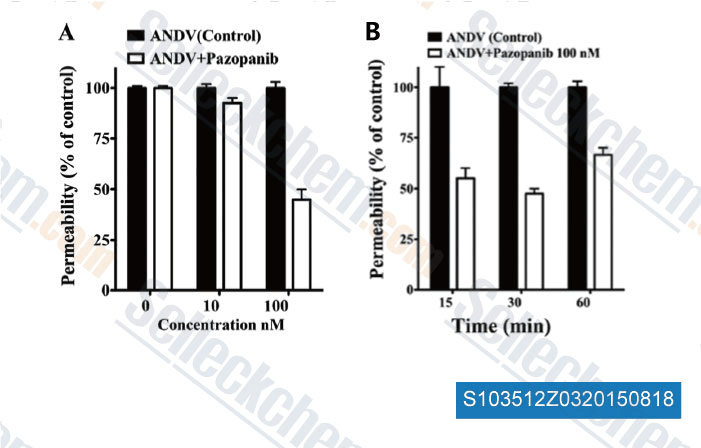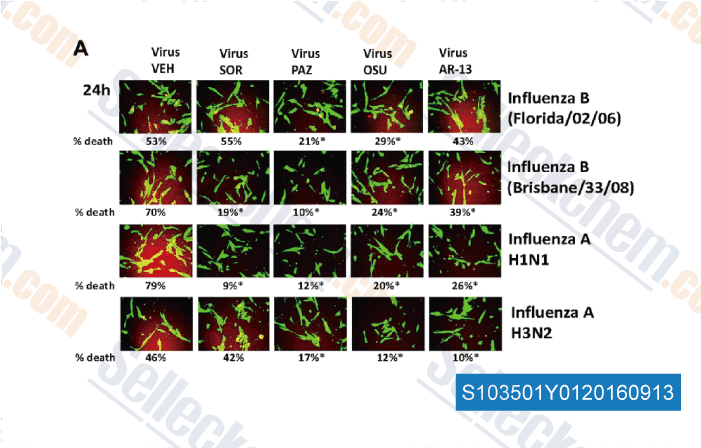|
Toll Free: (877) 796-6397 -- USA and Canada only -- |
Fax: +1-832-582-8590 Orders: +1-832-582-8158 |
Tech Support: +1-832-582-8158 Ext:3 Please provide your Order Number in the email. |
Technical Data
| Formula | C21H23N7O2S.HCl |
||||||
| Molecular Weight | 473.98 | CAS No. | 635702-64-6 | ||||
| Solubility (25°C)* | In vitro | DMSO | 32 mg/mL (67.51 mM) | ||||
| Water | Insoluble | ||||||
| Ethanol | Insoluble | ||||||
| In vivo (Add solvents to the product individually and in order) |
|
||||||
|
* <1 mg/ml means slightly soluble or insoluble. * Please note that Selleck tests the solubility of all compounds in-house, and the actual solubility may differ slightly from published values. This is normal and is due to slight batch-to-batch variations. * Room temperature shipping (Stability testing shows this product can be shipped without any cooling measures.) |
|||||||
Preparing Stock Solutions
Biological Activity
| Description | Pazopanib HCl is a novel multi-target inhibitor of VEGFR1, VEGFR2, VEGFR3, PDGFR, FGFR, c-Kit and c-Fms with IC50 of 10 nM, 30 nM, 47 nM, 84 nM, 74 nM, 140 nM and 146 nM in cell-free assays, respectively. Pazopanib induces autophagic Type II cell death. | |||||||||||
|---|---|---|---|---|---|---|---|---|---|---|---|---|
| Targets |
|
|||||||||||
| In vitro | Pazopanib potently inhibits VEGF-induced phosphorylation of VEGFR2 in HUVEC cells with IC50 of 8 nM. [1] Pazopanib shows dose-dependent growth inhibition in all synovial sarcoma cell lines including SYO-1 and HS-SY-II cells. Proliferation of SYO-1 and HS-SY-II cells is inhibited even at 1 µg/mL of Pazopanib and is completely abolished at 5 µg/mL. Pazopanib induces G1 arrest, and thereby suppresses the growth of synovial sarcoma cells. Phosphorylation of Akts, GSK-3β, JNKs, p70 S6 Kinase, and mTOR is suppressed in Pazopanib-treated SYO-1 cells compared with that in the vehicle-treated cells. [2] Pazopanib between 20 m g/mL and 22.5 m g/mL shows an increasing reduction of RPE cell viability. [3] | |||||||||||
| In vivo | The mice treated with 30 mg/kg or 100 mg/kg Pazopanib reveals a significant decrease in tumor burden compared with the mice treated with vehicle or 10 mg/kg Pazopanib. Treatment with Pazopanib is well-tolerated and there is no significant difference in the body weight among the mice in each group. [2] | |||||||||||
| Features | A multi-kinase inhibitor. |
Protocol (from reference)
| Kinase Assay: |
|
|---|---|
| Cell Assay: |
|
| Animal Study: |
|
References
|
Customer Product Validation

-
Data from [Data independently produced by Expert Opin Pharmacother, 2014, 15(11), 1489-99]

-
Data from [Data independently produced by , , J Virol, 2011, 85(5): 2296-303]

-
Data from [Data independently produced by , , J Cell Physiol, 2016, 231(10):2286-302.]
Selleck's Pazopanib HCl has been cited by 56 publications
| Cutoff value of IC50 for drug sensitivity in patient-derived tumor organoids in colorectal cancer [ iScience, 2023, 26(7):107116] | PubMed: 37426352 |
| Therapeutic and immunomodulatory potential of pazopanib in malignant phyllodes tumor [ NPJ Breast Cancer, 2022, 8(1):44] | PubMed: 35365682 |
| Establishment and Characterization of NCC-PMP1-C1: A Novel Patient-Derived Cell Line of Metastatic Pseudomyxoma Peritonei [ J Pers Med, 2022, 12(2)258] | PubMed: 35207746 |
| Establishment and characterization of NCC-UPS4-C1: a novel cell line of undifferentiated pleomorphic sarcoma from a patient with Li-Fraumeni syndrome [ Hum Cell, 2022, 10.1007/s13577-022-00671-y] | PubMed: 35118583 |
| Preclinical Evaluation of Ixabepilone in Combination with VEGF Receptor and PARP Inhibitors in Taxane-Sensitive and Taxane-Resistant MDA-MB-231 Breast Cancer Cells [ J Pharm Sci, 2022, 111(8):2180-2190] | PubMed: 35700798 |
| Pazopanib restricts small cell lung cancer proliferation via reactive oxygen species-mediated endoplasmic reticulum stress [ Thorac Cancer, 2022, 13(17):2421-2428] | PubMed: 35866204 |
| Proteogenomic characterization identifies clinically relevant subgroups of intrahepatic cholangiocarcinoma [ Cancer Cell, 2021, S1535-6108(21)00659-0] | PubMed: 34971568 |
| Integrated transcriptional-phenotypic analysis captures systemic immunomodulation following antiangiogenic therapy in renal cell carcinoma patients [ Clin Transl Med, 2021, 11(6):e434] | PubMed: 34185403 |
| Synergistic PIM kinase and proteasome inhibition as a therapeutic strategy for MYC-overexpressing triple-negative breast cancer [ Cell Chem Biol, 2021, S2451-9456(21)00400-1] | PubMed: 34525344 |
| Organoid cultures derived from patients with papillary thyroid cancer [ J Clin Endocrinol Metab, 2021, dgab020] | PubMed: 33524147 |
RETURN POLICY
Selleck Chemical’s Unconditional Return Policy ensures a smooth online shopping experience for our customers. If you are in any way unsatisfied with your purchase, you may return any item(s) within 7 days of receiving it. In the event of product quality issues, either protocol related or product related problems, you may return any item(s) within 365 days from the original purchase date. Please follow the instructions below when returning products.
SHIPPING AND STORAGE
Selleck products are transported at room temperature. If you receive the product at room temperature, please rest assured, the Selleck Quality Inspection Department has conducted experiments to verify that the normal temperature placement of one month will not affect the biological activity of powder products. After collecting, please store the product according to the requirements described in the datasheet. Most Selleck products are stable under the recommended conditions.
NOT FOR HUMAN, VETERINARY DIAGNOSTIC OR THERAPEUTIC USE.
